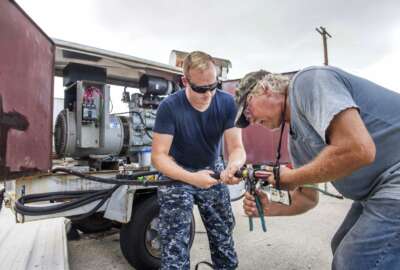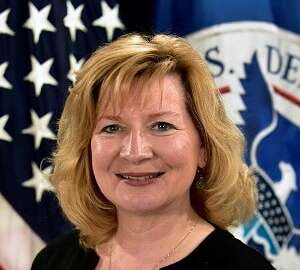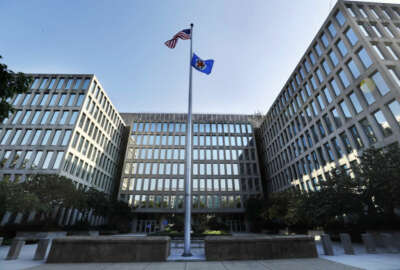
Pentagon launches effort to reinvigorate its ‘high risk’ HR workforce
The Defense Department is using a functional community approach to reexamine, retrain its HR workforce.
To listen to On DoD on your phone or mobile device, subscribe on PodcastOne or Apple Podcasts. The best listening experience on desktop can be found using Chrome, Firefox or Safari.
Since 2001, the Government Accountability Office has considered the federal government’s entire approach to human capital management to be an area of “high risk,” and the Defense Department is no exception.
But DoD’s latest approach to remedying the problem starts with the recognition that the HR profession itself is in trouble. It’s attempting to take an enterprisewide tack toward improving the way its human capital practitioners do their jobs through a construct called the “Human Resources Functional Community.”
The forum itself has existed in some form since 2006, but was re-launched in July to refocus on new ways to develop and train the HR workforce across the department, said Veronica Hinton, the Pentagon’s principal director for civilian personnel policy.
“As the government has continued to modernize, the HR workforce itself has not modernized at the same pace. Even though we’ve had this functional community for many years, we’ve worked more in a stovepiped manner within the department, and now we’re looking at an enterprise, collaborative, connected effort to get us on the path to design and develop the HR workforce that we need,” Hinton said in an interview for Federal News Radio’s On DoD. “Right now, our HR workforce is really burdened by the cumbersome complexity of our existing personnel framework. It’s difficult to navigate not only for our customers, but even for even our experienced human resource practitioners. That’s what makes it an occupation that we consider ‘high risk.’ We can’t do the business of government without people, and we need competent, engaged HR experts to attract, develop and inspire the next generation of federal talent.”
One of the functional community’s primary tasks will be to come up with an action plan for HR workforce development for the entire department.
The plan is first expected to detail the competencies HR employees need to have (and how many workers the department needs), and compare those goals against the existing “inventory” and work roles DoD has today.
Officials also aim to lay out clear career roadmaps and more formal credentialing and certification programs for HR workers. All of the above would be overseen by a new, yet-to-be-finalized governance structure that engages in more “active management” of the HR profession.
“As a community, we’ve tended to focus on building the capabilities and capacities of the broader workforce without the same level of focus on our HR professionals, who are supposed to be championing innovative, modern, strategic ways of managing the department’s workforce,” Hinton said. “We realized we no longer have the luxury to treat HR as this sort of back office function, focused solely on compliance and paperwork. We need them to be able to learn and apply new techniques for attracting and retaining employees of all ages. We want our professionals to be technical experts in federal HR regulations, but we also need them to balance that with a new focus on results-driven performance, accountability, and the ability to really be a strategic partner who works alongside other departments to build and maintain a thriving workforce.”
For example, Hinton, who is also DoD’s deputy chief human capital officer, said the department wants to prepare its HR staff to make far more use of data than they do today to design new personnel strategies.
“It’s not about producing widgets anymore. It’s not just things like checking the boxes for personnel actions or even the act of hiring, posting job announcements or assessing and certifying candidates,” she said. “Those are important things that we do, but now we need now we have access to so much data that we can leverage to make evidence based decisions and assess the effectiveness of our programs, and as we have more automation and artificial intelligence, that’s going to take over our widget production. We see this as a means to develop and inspire and challenge, and liberate our HR workforce so they can apply their best talents towards the most important missions of their organizations.”
Hinton promised the new push to reorient the HR workforce would be a collaborative effort, and that it would work together with the two-dozen other functional communities that represent particular sections of the broader Defense workforce.
At the re-launch event in July, senior Defense personnel officials discussed the action plan with 250 HR leaders from across the department. Hinton said the Pentagon has also held numerous focus groups with HR managers with the goal of getting buy-in and participation from HR managers within individual DoD components, aiming to account for differences in their various mission areas.
But even after a year of development, much about how the functional community will operate is still a work in progress, including how it will measure success or failure.
Hinton said the department is still in the process of settling on specific metrics to track the effort’s impact. But some measures are likely to be the degree to which the existing HR workforce is availing itself of new training opportunities, and whether or not HR practitioners are making more use of the department’s often-neglected special hiring authorities.
“If we’re transparent in creating a sharing of best practices — where things work well and where they work better — we can find some sort of common, standardized approaches to our set of complex challenges. We’ll be able to see if we’re actually moving in that direction,” she said. “And our non-HR customers should be able to see more engaged and inclusive strategic workforce planning from us across a wide range of occupations, skills and talents. Whether we’re improving time to hire, whether satisfaction with the HR community is increasing, whether we’re seeing a more productive workforce, those are all different metrics that we’re capturing in our human capital operating plan. Those are the metrics that we’re going to be looking at to see if this action plan is resulting in actual outcomes to strengthen the Defense human capital enterprise.”
Hinton said it was too early to say whether the functional community is likely to ask Congress for changes that would simplify or modify the legal structure that underpins the federal HR system.
“But what I will say is that we have a very complex, burdensome, outdated HR and personnel system that really just inhibits effective management of the workforce,” she said. “I would expect that message and that drumbeat to continue to be out there, and it may translate into legislative proposals.”
Copyright © 2025 Federal News Network. All rights reserved. This website is not intended for users located within the European Economic Area.
Jared Serbu is deputy editor of Federal News Network and reports on the Defense Department’s contracting, legislative, workforce and IT issues.
Follow @jserbuWFED





